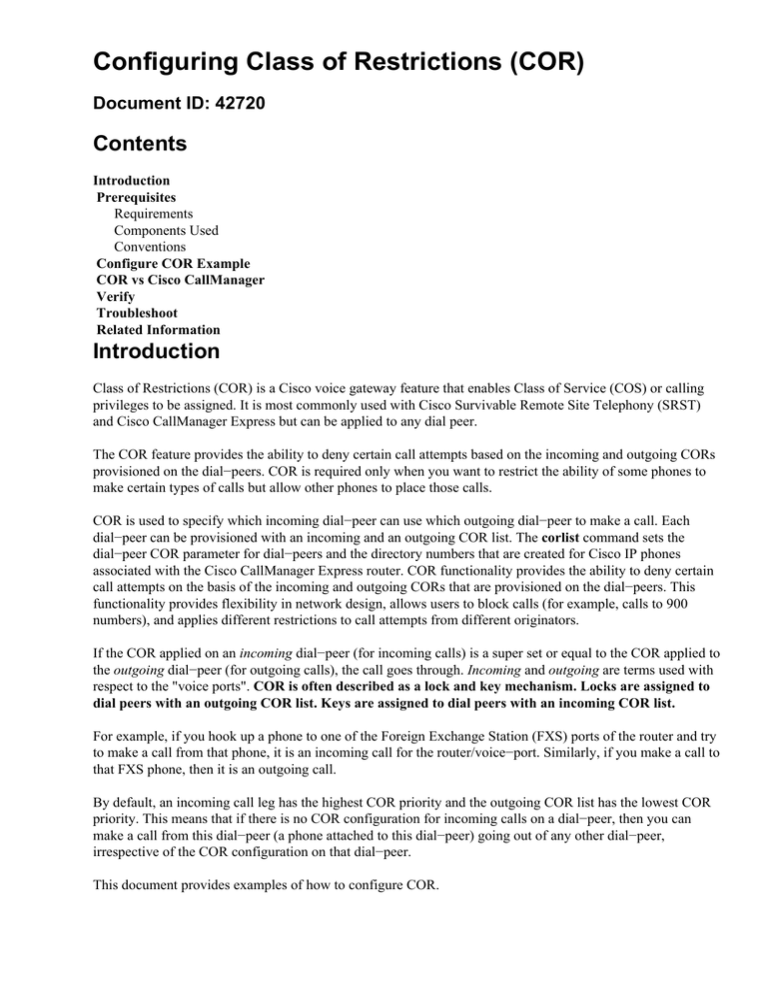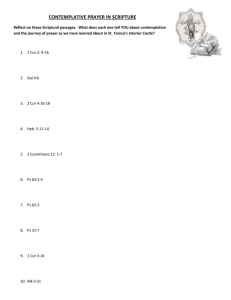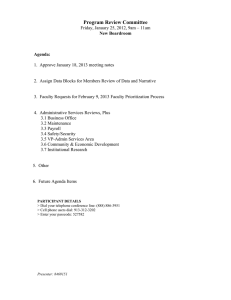
Configuring Class of Restrictions (COR)
Document ID: 42720
Contents
Introduction
Prerequisites
Requirements
Components Used
Conventions
Configure COR Example
COR vs Cisco CallManager
Verify
Troubleshoot
Related Information
Introduction
Class of Restrictions (COR) is a Cisco voice gateway feature that enables Class of Service (COS) or calling
privileges to be assigned. It is most commonly used with Cisco Survivable Remote Site Telephony (SRST)
and Cisco CallManager Express but can be applied to any dial peer.
The COR feature provides the ability to deny certain call attempts based on the incoming and outgoing CORs
provisioned on the dial−peers. COR is required only when you want to restrict the ability of some phones to
make certain types of calls but allow other phones to place those calls.
COR is used to specify which incoming dial−peer can use which outgoing dial−peer to make a call. Each
dial−peer can be provisioned with an incoming and an outgoing COR list. The corlist command sets the
dial−peer COR parameter for dial−peers and the directory numbers that are created for Cisco IP phones
associated with the Cisco CallManager Express router. COR functionality provides the ability to deny certain
call attempts on the basis of the incoming and outgoing CORs that are provisioned on the dial−peers. This
functionality provides flexibility in network design, allows users to block calls (for example, calls to 900
numbers), and applies different restrictions to call attempts from different originators.
If the COR applied on an incoming dial−peer (for incoming calls) is a super set or equal to the COR applied to
the outgoing dial−peer (for outgoing calls), the call goes through. Incoming and outgoing are terms used with
respect to the "voice ports". COR is often described as a lock and key mechanism. Locks are assigned to
dial peers with an outgoing COR list. Keys are assigned to dial peers with an incoming COR list.
For example, if you hook up a phone to one of the Foreign Exchange Station (FXS) ports of the router and try
to make a call from that phone, it is an incoming call for the router/voice−port. Similarly, if you make a call to
that FXS phone, then it is an outgoing call.
By default, an incoming call leg has the highest COR priority and the outgoing COR list has the lowest COR
priority. This means that if there is no COR configuration for incoming calls on a dial−peer, then you can
make a call from this dial−peer (a phone attached to this dial−peer) going out of any other dial−peer,
irrespective of the COR configuration on that dial−peer.
This document provides examples of how to configure COR.
Prerequisites
Requirements
Before you attempt this configuration, ensure that you are familiar with how to configure a Cisco IOS
Telephony Service on a router. Cisco IOS Telephony Service version 3.0 is referred to as CallManager
Express 3.0.
Components Used
The information in this document is based on these software and hardware versions:
• Cisco IOS® Software Release 12.2(8)T or later with a minimum of IP Plus (IP/VOX Plus on the
Cisco 1700 series) feature set. This document assumes Cisco IOS Telephone Services (ITS) 2.0
support in Cisco IOS Software Release 12.2(8)T or later. Refer to Cisco IOS Telephony Services
Version 2.1 for more information on ITS and Cisco IOS Software releases.
• Cisco 3725 Gateway with Cisco IOS Software Release 12.3(4)T with the IP Plus feature set is used in
the configuration example, although most IAD 2400s, 1700, 2600, 2800, 3600, 3700, 3800 series
routers are currently applicable. Cisco CallManager Express 3.0 is supported in Cisco IOS Software
Release 12.4(10). Check the Cisco IOS release notes for current version and software support
information.
The information in this document was created from the devices in a specific lab environment. All of the
devices used in this document started with a cleared (default) configuration. If your network is live, make sure
that you understand the potential impact of any command.
Conventions
Refer to Cisco Technical Tips Conventions for more information on document conventions.
Configure COR Example
Figure 1 illustrates the concept of COR lists.
Use this procedure as an example for how to configure COR:
ephone−dn COR list
incoming
1001
1002
1003
1004
Calling Patterns
Engineering
911, 408.... (local_call) and
316&.numbers
HR
911, 1800.... , 408.... (local_call)
and 316&. numbers
Manager
911, 1800.... , 1900....,
408....(local_call) and 316&.
numbers
none
can call all the numbers possible
from the router R1.
1. Configure dial−peer cor custom and assign a meaningful name that specifies the way CORs apply to
dial−peers. For example:
Dial−peer cor custom
name 911
name 1800
name 1900
name local_call
2. Create the actual lists of the restrictions that apply to the dial−peer.
Dial−peer cor list call911
Member 911
Dial−peer cor list call1800
Member 1800
Dial−peer cor list call1900
Member 1900
Dial−peer cor list calllocal
Member local_call
Dial−peer cor list Engineering
Member 911
Member local_call
Dial−peer cor list Manager
Member 911
Member 1800
Member 1900
Member local_call
Dial−peer cor list HR
Member 911
Member 1800
Member local_call
3. Create dial−peers and specify the COR list to be used.
In this example, five dial−peers are created for the destination numbers 408&., 1800&, 1900&, 911,
and 316&. The appropriate corlist is applied to each of the dial−peers.
Dial−peer voice 1 voip
Destination−pattern 408&.
Session target ipv4:1.1.1.1
Corlist outgoing calllocal
Dial−peer voice 2 voip
Destination−pattern 1800&
Session target ipv4:1.1.1.1
Corlist outgoing call1800
Dial−peer voice 3 pots
Destination−pattern 1900&
Port 1/0/0
Corlist outgoing call1900
Dial−peer voice 4 pots
Destination−pattern 911
Port 1/0/1
Corlist outgoing call911
Dial−peer voice 5 pots
Destination−pattern 316&.
Port 1/1/0
Note: There is no COR applied on the dial−peer 5 POTS.
Note: If either the incoming dial peer or the outgoing dial peer does not have a COR list applied, the
call succeeds.
Use the telephony−service command in global configuration mode to enter telephony−service
configuration mode to configure a Cisco CallManager Express system. By default, no Cisco
CallManager Express or ITS configuration is present.
4. Apply the COR list to the individual phones/Ephone−dns.
Ephone−dn 1
Number 1001
Cor incoming Engineering
Ephone−dn 2
Number 1002
Cor incoming HR
Ephone−dn 3
Number 1003
Cor incoming Manager
Ephone−dn 4
Number 1004
Note: On the Ephone−dn 4 there is no COR applied.
With this configuration:
• Ephone−dn 1 (1001) can call 408&., 911, and 316&.numbers.
• Ephone−dn 2 (1002) can call 408&., 1800... , 911, and 316&. numbers.
• Ephone−dn 3 (1003) can call all the numbers possible from that router.
• Ephone−dn 4 (1004) can call all the numbers possible from that router.
Note: All Ephone−dns can call 316&. numbers.
Various combinations of COR lists and the results are shown in this table:
COR List
on
Incoming
dial−peer
No COR.
No COR.
The COR
list applied
for
incoming
calls.
The COR
list applied
for
incoming
calls (super
set of COR
lists applied
for
outgoing
calls on the
COR List
on
Outgoing
No
COR.
dial−peer
COR list
applied for
outgoing
calls.
No COR.
Result
Call
succeeds.
Reason
COR is not in the
picture.
Call
succeeds.
The incoming
dial−peer, by default,
has the highest COR
priority when no COR
is applied. Therefore, if
you apply no COR for
an incoming call leg to
a dial−peer, then this
dial−peer can make
calls out of any other
dial−peer, irrespective
of the COR
configuration on the
outgoing dial−peer.
Call
succeeds.
The outgoing
dial−peer, by default,
has the lowest priority.
Since there are some
COR configurations for
incoming calls on the
incoming/originating
dial−peer, it is a super
set of the outgoing call
COR configurations on
the
outgoing/terminating
dial−peer.
The COR
Call
list applied succeeds.
for outgoing
calls (subset
of COR lists
applied for
incoming
calls on the
incoming
dial−peer.)
The COR list for
incoming calls on the
incoming dial−peer is a
super set of COR lists
for outgoing calls on
the outgoing dial−peer
outgoing
dial−peer).
The COR
list applied
for
incoming
calls (subset
of COR lists
applied for
outgoing
calls on the
outgoing
dial−peer).
The COR
list applied
for outgoing
Call cannot COR lists for incoming
calls (super
be
calls on the incoming
set of COR
completed dial−peer are not a
lists applied
using this super set of COR lists
for
outgoing
for outgoing calls on
COR vs incoming
Cisco CallManager
dial−peer. the outgoing dial−peer.
calls on the
incoming
• The COR
feature in the Cisco IOS Software feature is like a Cisco CallManager calling search space
dial−peer).
and partitions.
• Cisco IOS Software bases its restriction via dial−peer matching. The Cisco CallManager does it based
on digit analysis.
• The dial−peer cor custom command is equivalent to creating Cisco CallManager partitions.
• The dial−peer cor list command is equivalent to creating a Cisco CallManager calling search space
with partitions in it.
Partitions and calling search spaces provide the capability for implementing calling restrictions and creating
closed dial groups on the same Cisco CallManager. There are resemblances between the COR operation and
the Cisco CallManager calling search spaces and partitions feature. The one thing that COR cannot do is
separate line and device calling search spaces and partitions like Cisco CallManager can.
Verify
After you enter the configurations shown in this document into your router, it is important that you verify the
network is operating correctly. These commands and respective output show you a successful implementation
of the configurations in this document.
Certain show commands are supported by the Output Interpreter Tool (registered customers only) , which
allows you to view an analysis of show command output.
• show ephone−dn summary Displays brief information about Cisco IP phone extensions
(Ephone−dns),
• show telephony−service ephone−dn Displays information about extensions (Ephone−dns) in a
Cisco CallManager Express system.
• show telephony−service dial−peer Displays dial−peer information for extensions in a Cisco
CallManager Express system
• show telephony−service all Displays detailed configuration for phones, voice ports, and dial−peers
in a Cisco CallManager Express system.
• show dial−peer corDisplays the list of corlist and the members in each list.
This is sample output of some of the commands with respect to the configuration in this document:
Router3725#show ephone−dn summary
PORT
DN STATE
MWI_STATE
CODEC
VAD VTSP STATE
VPM STATE
======== ========== ============ ======== === ===================== =========
50/0/1
50/0/2
50/0/3
50/0/4
CH1
CH1
CH1
CH1
IDLE
IDLE
IDLE
IDLE
NONE
NONE
NONE
NONE
−
−
−
−
Router3725#show telephony−service dial−peer
dial−peer voice 20001 pots
destination−pattern 1001
calling−number local
huntstop
corlist incoming Engineering
progress_ind setup enable 3
port 50/0/1
dial−peer voice 20002 pots
destination−pattern 1002
calling−number local
huntstop
corlist incoming HR
progress_ind setup enable 3
port 50/0/2
dial−peer voice 20003 pots
destination−pattern 1003
calling−number local
huntstop
corlist incoming Manager
progress_ind setup enable 3
port 50/0/3
dial−peer voice 20004 pots
destination−pattern 1004
calling−number local
huntstop
progress_ind setup enable 3
port 50/0/4
Router3725#show dial−peer cor
Class of Restriction
name: 911
name: 1800
name: 1900
name: local_call
COR list <call911>
member: 911
COR list <call1800>
member: 1800
COR list <call1900>
member: 1900
COR list <calllocal>
member: local_call
COR list <Engineering>
member: 911
member: local_call
COR list <Manager>
member: 911
member: 1800
−
−
−
−
−
−
−
−
EFXS_ONHOOK
EFXS_ONHOOK
EFXS_ONHOOK
EFXS_ONHOOK
member: 1900
member: local_call
COR list <HR>
member: 911
member: 1800
member: local_call
Troubleshoot
This section provides information you can use to troubleshoot your configuration.
Place a few test calls over the gateways through the IP WAN or the PSTN to verify that your configuration is
correct. You can see if the call that comes into the gaetway is ringing when you run a debug on the target
gateway.
Refer to the instructions in Cisco IOS Telephony Service (ITS) Configuration and Troubleshooting for
additional information on troubleshooting.
• debug voip ccapi inout Used to debug end−to−end VoIP calls.
• debug ephone detail Used to set detail debugging for the Cisco IP phone.
Note: Refer to Important Information on Debug Commands before you issue debug commands.
Related Information
• Cisco Unified Communications Manager Express System Administrator Guide
• Understanding Dial Peers and Call Legs
• Understanding Inbound and Outbound Dial Peers Matching
• Configuring Dial Plans, Dial Peers, and Digit Manipulation
• Troubleshooting and Debugging VoIP Call Basics
• Voice Technology Support
• Voice and Unified Communications Product Support
• Troubleshooting Cisco IP Telephony
• Cisco Unified Communications Manager Express Command Reference
• Technical Support & Documentation − Cisco Systems
Contacts & Feedback | Help | Site Map
© 2013 − 2014 Cisco Systems, Inc. All rights reserved. Terms & Conditions | Privacy Statement | Cookie Policy | Trademarks of
Cisco Systems, Inc.
Updated: Oct 31, 2007
Document ID: 42720



